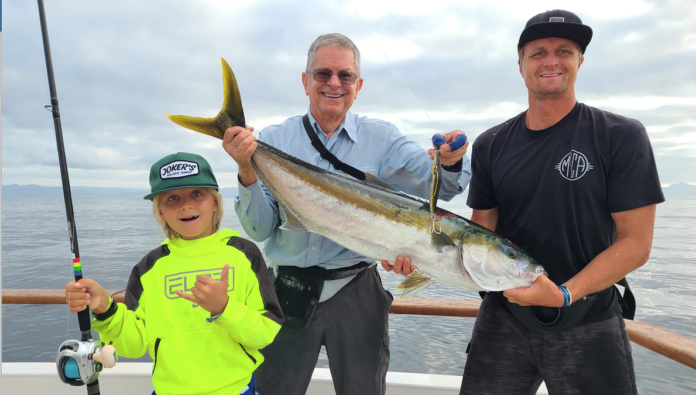BY LARRY BROWN
Yellowtail are the gold standard for West Coast anglers. They are brutally strong, great eating and can be caught using bait, jigs, dropper loop and trolling. They are twice as strong as any tuna, pound-for-pound, and they never give up until they are on the gaff. Yellowtail are also more intelligent and challenging than the other fish we target. Like us primates, yellowtail use tools. Kelp, rocks, reefs, lobster pots, pilings and offshore oil platforms are all tools for their escape artistry.
When a tuna is hooked near a kelp paddy, it will run deep and away from the kelp. Stupid tuna. Yellowtail know the exact location of every strand of kelp, every sharp rock and any other obstacle within 100 yards of every meal and put every ounce of strength and heart into their struggle to reach it and regain their freedom. They are among our most noble and toughest adversaries. And they can be targeted year-round. They are the perfect California gamefish.
Let’s discuss each of the common ways to target yellowtail.
Best baits for yellowtail fishing
Yellowtail are opportunity feeders and can be caught on many different live and dead baits: live sardines, anchovies, mackerel and squid are their favorite meals. They will also strike dead squid, slabbed mackerel or whitefish fillets and stripped bait as well.
When using live baits, bait selection is critical. Baits should be very healthy, strong, brightly colored and fast. The one you can’t catch in the bait well is the one you want on your hook. Do not select baits with damaged scales, red noses or eyes or white or red spots anywhere.
Lighter colored, almost pastel green and light grey colors are the primo baits and will stand out from the darker-bodied baits. They will normally be swimming below the darker ones and freak out when they detect the shadow of your hand or bait scoop. Try to scoop up only one or two baits, try to minimize the trauma to all baits, return the unused baits to the bait tank quickly and never leave the bait scoop in the bait well. It acts just like a gill net, damaging the remaining baits, and it pisses off the captain and crew.
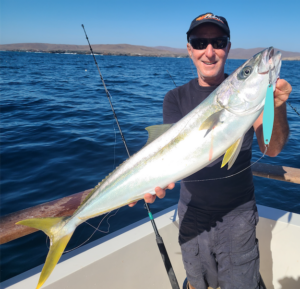
Selecting the best bait and getting it in the water as gently and quickly as possible is critical. Before you touch a bait, dunk your hand in the bait well to lubricate your palms. This will reduce the friction of your skin against the bait’s scales and minimize damage to the bait. Hold your hand calmly in the bait well to calm down the baits.
Attacking them quickly with your hand will spook them and I guarantee the healthiest baits you want to grab can swim faster than you can grab. Hold your hand in the corner of the well and when your chosen bait calmly swims over your hand, slowly and calmly lift up your hand and the bait will just wilt in your palm.
Hold onto the bait very gently. Do not squeeze it. If you drop the bait, do not use it, just discard it or boot it over the side. Quickly pin the bait on your hook, grab the line about 6 inches above the hook and let go of the bait. Then quickly walk to the rail and gently cast the bait.
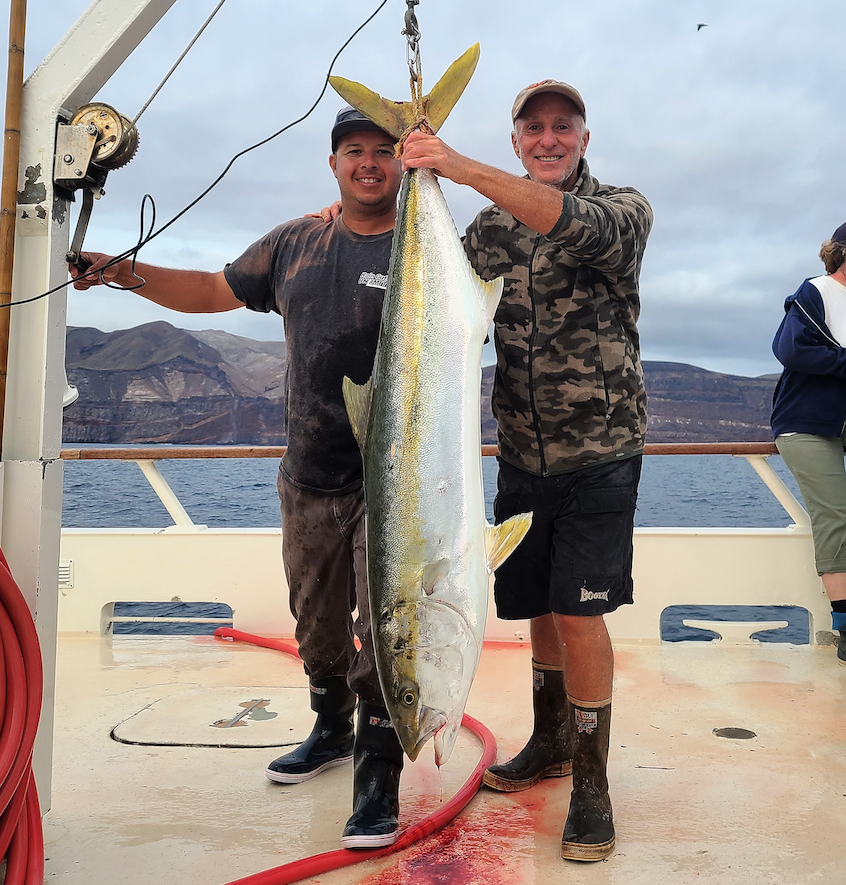
Casting a bait is an art. A gentle, lofty cast with good distance are all critical. This is enhanced with a small reel with super free spool and a long rod with a soft tip. My favorite outfit for fishing sardines is my Avet MX Raptor and my Phenix PHD 869HX, rated at 25 to 60 pounds.
Using J-hooks or circle hooks is a personal preference but yellowtail don’t have sharp teeth that can bite through your line, so J-hooks are most anglers’ preference. Match the hook size to your line test and size of the bait. It’s always a good idea to ask the deckhand what size hook to use.
For small anchovies and line under 30-pound test, use a #4 hook. For large anchovies and very small sardines you can use #2, #1 or even #1/0 hooks. Medium-sized sardines can handle 1/0 or 2/0 hooks. For large sardines and heavier line, use 2/0 to 4/0 hooks. Mackerel and squid require 4/0 to 6/0 hooks depending again on the size of the bait and line test. For smaller fin baits and lighter lines, use the thinner wire live bait hooks. Forty- and 50-pound line can straighten light wire hooks, so use the heavy wire hooks.
Lastly, small hooks are stealthier and get more bites, but large hooks grab more meat, have more holding power, and result in fewer pulled hooks and lost fish. If the bite is very picky, scratchy or if the fish are line or hook shy, use smaller hooks. When they are stupid and chewing everything, use bigger hooks — that’s the general rule of the bait game.
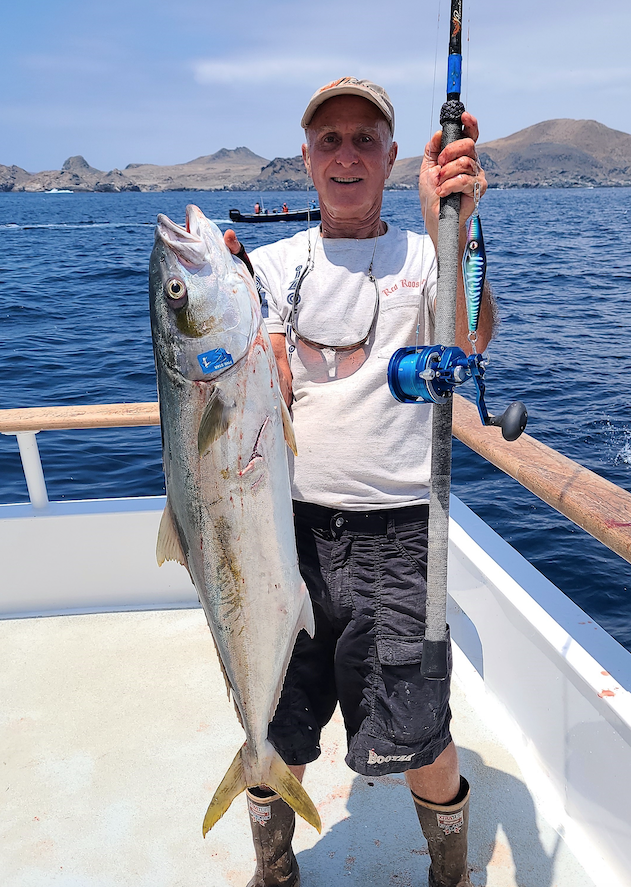
Where to hook a bait is also an important subject. Hooking a live bait through the nose is probably the most common tactic. If you have a strong current or expect a long soak time because the fish are boiling 100 yards from the boat, or if you are using a weight of any kind, only nose hook your bait. Gently insert the point of the hook sideways through the nostrils in the small white cartilage between the eyes and end of the nose. Stay clear of the eyes.
One of my favorite methods is to shoulder hook my sardines, just behind the skull. The hook lays on top of the bait, which will be less visible to predators, which always attack from below. Nose and shoulder hooking will allow you to fish the bait when slowly winding in, which frequently induces a strike. Wind your baits in slowly and hang on.
You can also collar hook your anchovies or sardines. Be extremely gentle and insert the hook just under the hard C-shaped material at the edge of the body just next to and under the gill plate. The hook should cause no bleeding and the bait should freely dangle and freely swim.
Sardines and mackerel can also be butt hooked. Gently pass the hook just under the surface cartilage just under the anal fins. You should draw no blood. Blood means you’ve gone too deep. Butt hooking baits encourages them to swim down and away from the boat, hopefully straight into the mouth of a hungry yellowtail.
Whereas nose and shoulder hooked baits may also get bit if retrieved slowly back to the boat, this advantage is lost with butt hooked baits. Butt hooked baits require an even more gentle and lofty cast. If you are not an expert at a gentle loft cast, a smooth underhand pendulous cast gets the bait headed in the right direction when it hits the water. Butt hooked baits are easier to feel in the water. Whenever they stop swimming, sometimes back spooling and a slight twitch is just enough aggravation to get them to peel off another few yards of line, which frequently triggers a strike.
Squid is a favorite bait when in season and is very easy to use. All gamefish love squid. Fly-lining or using a sliding sinker and hook to match the bait’s size and line test, just pin the hook through the mantle of the squid and let it drift in the current.
Slabs and strips of filleted mackerel or whitefish can also be lethal baits. Strips can be fished just like squid. Cut 1- by 4-inch strips, slightly tapered from a filet and pin one on a sliding sinker set-up. Slabs are also used on dropper loops and will be discussed further in that section.
The hookset is critical for yellowtail. They frequently grab a larger bait sideways and carry it for a few seconds before they turn it and swallow it. A typical strike resembles a freight train picking up your bait and screaming towards the horizon. For small baits, let it run for just 1 to 2 seconds; for large sardines let it run for 3 to 4 seconds; for mackerel let it run for at least 5 to 6 seconds, which will usually seem like a lifetime.
When your bait is picked up, point the rod tip right at the fish. After the required wait time, put the reel in gear, continue to point the rod tip at the fish and wind down on the fish until you feel the rod load up. Only when you feel the full weight of the hooked fish on your line and it is stripping line off under drag should you raise your rod. With circle hooks, just gently raise the rod and begin your fight. With J-hooks, give the fish a solid hook set to drive the point home.
The fight is not over until the fish is gently released or gaffed and in the boat. The longer the fish is in the water, the more likely it is to be lost due to sharks, sea lions, tangles, saw-offs and hooks pulling out. When the fish is straight up and down, shift your lever drag towards full and finish your business. And remember to keep the fish’s head in the water when your deckhand is trying to gaff it.
Best jigs for yellowtail fishing
Using jigs or iron is one of the most productive and exciting ways to catch yellowtail. The most popular colors are blue and white, tones of brown and yellow called scrambled egg and mint, but I don’t think color is nearly as important as action. If a jig swims well, any color will work. Captain Sam Moore on the Intrepid always says, “the best color is speed.”
There are two types of iron and two methods for using them: surface and yo-yo. Only one requires much skill. Yo-yoing is like iron for dummies, and I love it. Yo-yo jigs are heavy. The most common and effective are the Salas 6X Jr, 6X, Tady 9, nearly all of the JRI models.
I’ve had particular success with the JRI ST-6 and ST6J, DW-1 and Stinger models. Just drop the jig straight down to the bottom or cast it out and let it sink to the bottom, put the reel in gear, point the rod down at the fish and wind as fast as you possibly can. This is where a strong, high-speed reel is critical and a stout rod is preferred. The Avet JX and HX Raptors are awesome reels for this use. So is the Penn Torque 40, the Daiwa Saltiga and Saltist and the Shimano Trinidad A 20 or 40N. The Phenix PHD, PSW or AXIS HAV rods in the XH weight (30- to 80-pound) are perfect rods for yoyoing.
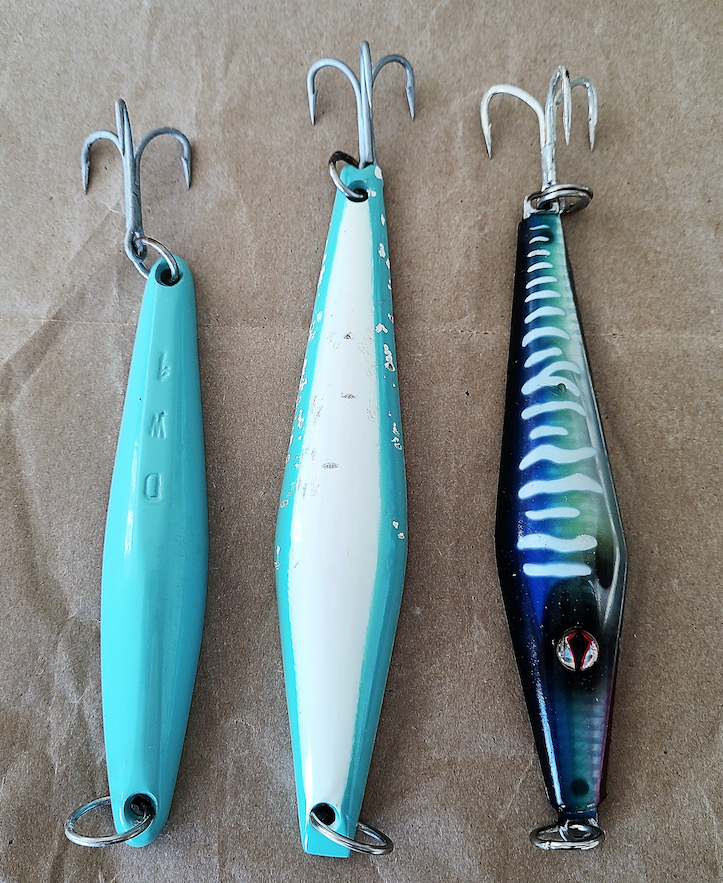
Use 50- or 60-pound line and a stupid-tight drag to minimize line stretch and to assure you can muscle him away from structure. You cannot reel too fast! To save energy, wind it up a third to halfway, stop, drop and do it again — 80% of the strikes come in the lower third of the water column. You sometimes get bit on the sink, so be prepared to instantly put it in gear and reel like hell.
Do not set the hook; reel through the bite, with the rod pointed down towards the fish. Most mistakes are made by trying to set the hook. Think physics — a sharp hook traveling up at warp speed will penetrate — and don’t set the hook. Just reel, reel, reel. When he starts to take line you can then, and only then, give him a quick left hook, but it’s more for ego than necessity.
You can also use these heavy jigs on top. A long cast, a varied sink between 5 and 20 seconds and a fast retrieve can sometimes be lethal. Remember to keep reeling through the strike!
Surface iron is not for dummies. It really does take skill to master. Most deckhands are masters and will likely be willing to coach you for several casts and retrieves so you get it. Surface irons are the lighter models of jigs and require a finesse retrieve to make them flutter and behave correctly. Surface models which are especially lethal are the JRI 4 and DW-1, Nomad Slidekick, Salas 7X and Tady 45.
Action seems much more critical than color. Every surface iron may swim differently so you have to watch it and adjust your retrieve until you get the perfect wiggle, flutter and kick. Polarized glasses are critical tools. So is a long rod or jig stick of 8, 9 or even 10 feet, and a smooth reel with great free spool for long casts.
The Avet MXL and JX, Daiwa Saltist and Saltiga, Penn Torque and Shimano Trinidad A 20 or 40N are all ideal for surface iron. Use 50-pound mono or all braid with a short 5- to 6-foot fluorocarbon leader. My favorite rod for surface iron is the Phenix PHD800xh, rated at 30 to 80 pounds.
A long cast, hopefully towards feeding fish, and a varied sink of between 3and 10 seconds starts this technique. Point the rod towards the fish and begin your steady retrieve, which gives you the perfect wiggle/flutter/kick that you perfected with your practice casts for that specific iron. Sometimes you will actually see the yellowtail pushing towards the iron like a submarine on the surface and it’s nearly impossible to contain your excitement.
Keep calm and keep reeling. Then a savage strike. Keep reeling; do not set the hook. Sound familiar? Keep reeling through the strike, to make sure all of the line stretch is out of the mono. Only consider setting the hook when your quarry is peeling off line heading for the horizon.
There is nothing more exciting, no adrenaline rush, no experience in the world like fishing iron. Watching and feeling the surface iron getting inhaled by a big yellowtail or winding in a yo-yo iron at Mach 4 speed and feeling the sudden thud of a strike takes your breath away.
The new Buffalo and Streaker knife-style jigs also work on yellowtail and are definitely worth trying, too.
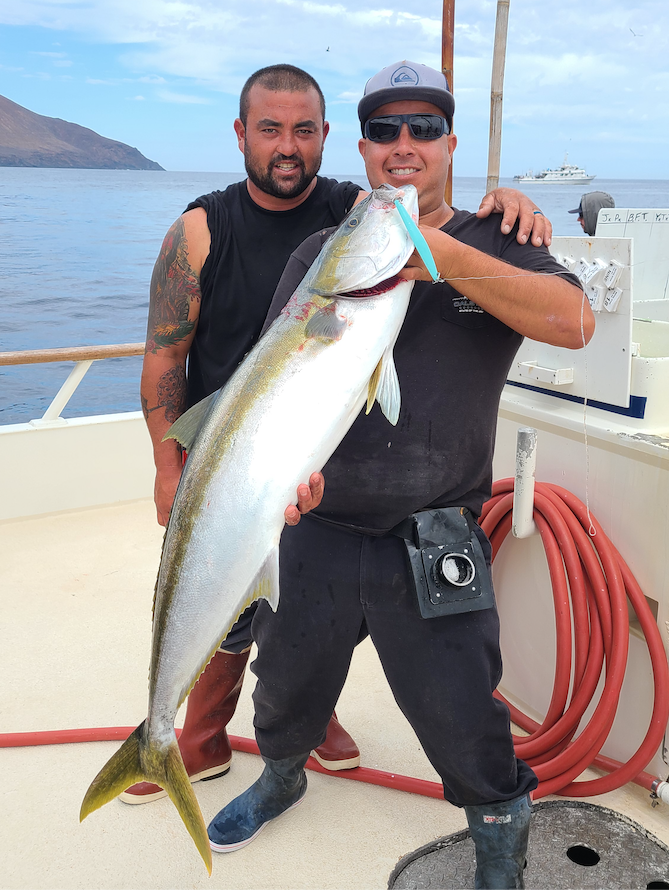
Dropper loops for yellowtail fishing
Dropper loop fishing is one of the most productive ways to catch yellowtail, and my personal least favorite. A heavy reel and rod lined with 60- to 100-pound-test and a lead weight heavy enough to get you to the bottom and keep you there in a swift current are the basic tools. I suggest going all Spectra with about 50 yards of mono so the inevitable tangles are easier to resolve, and if you do lose line in the tangles mono is cheaper than braid. Use a stupid-tight drag to assure your yellowtail can’t rock you. Tie an 18- to 24-inch surgeon’s loop about 4 feet from the tag end of the line upon which you will tie the hook with a strong knot. Use a large J-hook, 5/0 to 8/0, or a circle hook depending on the size of your bait and preference.
Add your weight at the bottom tag end using a weak swivel or loop so you can change the size of weight if needed and so it will fail if the weight gets caught in the rocks with a yellowtail on your hook. Nose hook a sardine, mackerel, live or dead squid or a large slab from a filet of mackerel or whitefish, drop it to the bottom, wind up 3 cranks, put it in gear and be ready to reel immediately to get the beast off the bottom and away from the sharp rocks. Dropper loops are not glamorous, but they are deadly.
Heavier duty rods and reels are musts for this style of fishing. The Avet 30 EX or HX Raptor, Shimano Talica 25 and other heavier model reels and a stiff rod like the Phenix PHD 700X2H or Avis HAV700 X2H, both rated 40 to 100 pounds are perfect choices for pulling these beasts off the bottom.
Yellowtail are the perfect game fish for California anglers. They are strong, smart adversaries with big hearts. They can be caught using all the common techniques, can be targeted all months of the year and are great on the dinner table. I love fishing for yellowtail.

